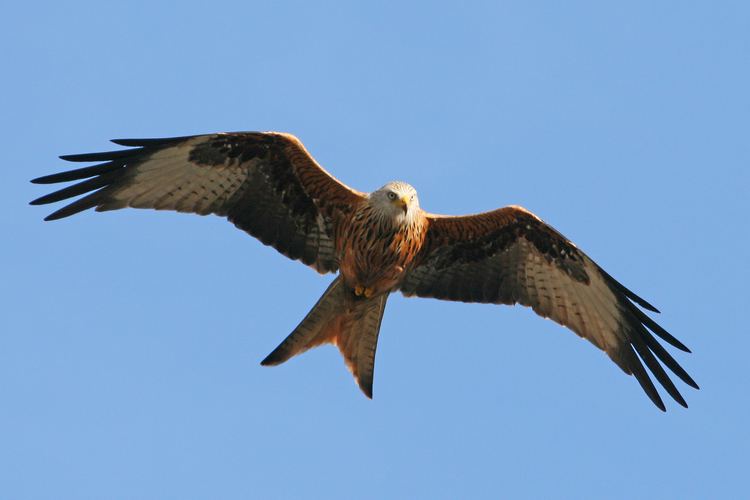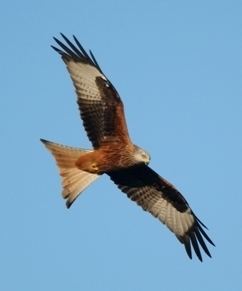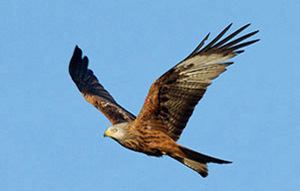Subfamily Milvinae Rank Species | Phylum Chordata Genus Milvus Higher classification Milvus | |
 | ||
Similar Bird, Milvus, Black kite, Common buzzard, Western marsh harrier | ||
Wales red kite rode wouw feeding station at rhayader hd video
The red kite (Milvus milvus) is a medium-large bird of prey in the family Accipitridae, which also includes many other diurnal raptors such as eagles, buzzards, and harriers. The species is currently endemic to the Western Palearctic region in Europe and northwest Africa, though formerly also occurred just outside in northern Iran. It is resident in the milder parts of its range in western Europe and northwest Africa, but birds from northeastern and central Europe winter further south and west, reaching south to Turkey. Vagrants have reached north to Finland and south to Israel, Libya and Gambia.
Contents
- Wales red kite rode wouw feeding station at rhayader hd video
- Red kites in slow motion the slow mo guys
- Taxonomy
- Description
- Differences between adults and juveniles
- Diet
- Breeding
- Distribution and status
- Continental Europe
- United Kingdom
- Ireland
- Sweden
- Populations and trends by country
- Observation
- References

Red kites in slow motion the slow mo guys
Taxonomy

The red kite was described by the Swedish naturalist Carl Linnaeus in 1758 in the 10th edition of his Systema Naturae under the binomial name Falco milvus. The word milvus was the Latin name for the bird. In 1799 the French naturalist Bernard Germain de Lacépède moved the species to the genus Milvus creating the tautonym.

The red kite has been known to successfully hybridize with the black kite in captivity where both species were kept together, and in the wild on the Cape Verde Islands and infrequently in other places. The red kites on the Cape Verde Islands are (or rather were) quite distinct in morphology, being somewhat intermediate with black kites. The question whether the Cape Verde kite should be considered a distinct species (Milvus fasciicauda) or a red kite subspecies has not been settled. A mitochondrial DNA study on museum specimens suggested that Cape Verde birds did not form a monophyletic lineage among or next to red kites. This interpretation is problematic: mtDNA analysis is susceptible to hybridization events, the evolutionary history of the Cape Verde population is not known, and the genetic relationship of red kites is confusing, with geographical proximity being no indicator of genetic relatedness and the overall genetic similarity high, perhaps indicating a relict species. Given the morphological distinctness of the Cape Verde birds and that the Cape Verde population was isolated from other populations of red kites, it cannot be conclusively resolved as to whether the Cape Verde population was not a distinct subspecies (as M. migrans fasciicauda) or even species that frequently absorbed stragglers from the migrating European populations into its gene pool. The Cape Verde population became effectively extinct since 2000, all surviving birds being hybrids with black kites.
Description

Red kites are 60 to 70 cm (24 to 28 in) long with a 175–179 cm (69–70 in) wingspan; males weigh 800–1,200 g (28–42 oz), and females 1,000–1,300 g (35–46 oz). It is an elegant bird, soaring on long wings held at a dihedral, and long forked tail, twisting as it changes direction. The body, upper tail and wing coverts are rufous. The white primary flight feathers contrast with the black wing tips and dark secondaries. Apart from the weight difference, the sexes are similar, but juveniles have a buff breast and belly. Its call is a thin piping sound, similar to but less mewling than the common buzzard. There is a rare white leucistic form accounting for approximately 1% of hatchlings in the Welsh population but is at a disadvantage in the survival stakes.
Differences between adults and juveniles
Adults differ from juveniles in a number of characteristics:

These differences hold throughout most of the first year of a bird's life.
Diet

The red kite's diet consists mainly of small mammals such as mice, voles, shrews, young hares and rabbits. It feeds on a wide variety of carrion including sheep carcasses and dead game birds. Live birds are also taken and occasionally reptiles and amphibians. Earthworms form an important part of the diet, especially in spring.

As scavengers, red kites are particularly susceptible to poisoning. Illegal poison baits set for foxes or crows are indiscriminate and kill protected birds and other animals. There have also been a number of incidents of red kites and other raptors being targeted by wildlife criminals.
Breeding
Although adult red kites are sedentary birds, occupying their breeding home range all year in most cases, populations from Central and Northern Europe—although not the United Kingdom—may migrate south to areas such as Spain and the Iberian peninsula during colder winters. Each nesting territory can contain up to five nest sites. Both male and female birds build the nest on a main fork or a limb high in a tree, 12–20 m (39–66 ft) above the ground. The nest is made of twigs and lined with grass or other vegetation and sheep’s wool. At signs of danger, a mother will signal the young who will "play dead" when a predator is near.
Distribution and status
Red kites inhabit broadleaf woodlands, valleys and wetland edges, to 800 metres (2,600 ft). They are endemic to the western Palearctic, with the European population of 19,000–25,000 pairs encompassing 95% of its global breeding range. It breeds from Spain and Portugal east into central Europe and Ukraine, north to southern Sweden, Latvia and the UK, and south to southern Italy. There is a population in northern Morocco. Northern birds move south in winter, mostly staying in the west of the breeding range, but also to eastern Turkey, northern Tunisia and Algeria. The three largest populations (in Germany, France and Spain, which together hold more than 75% of the global population) declined between 1990 and 2000, and overall the species declined by almost 20% over the ten years. The main threats to red kites are poisoning, through illegal direct poisoning and indirect poisoning from pesticides, particularly in the wintering ranges in France and Spain, and changes in agricultural practices causing a reduction in food resources. Other threats include electrocution, hunting and trapping, deforestation, egg-collection (on a local scale) and possibly competition with the generally more successful black kite M. migrans.
Continental Europe
German populations declined by 25%–30% between 1991 and 1997, but have remained stable since. The populations of the northern foothills of the Harz Mountains (the most densely populated part of its range) suffered an estimated 50% decline from 1991 to 2001. In Spain, the species showed an overall decline in breeding population of up to 43% for the period 1994 to 2001–02, and surveys of wintering birds in 2003–04 suggest a similarly large decline in core wintering areas. The Balearic Islands population has declined from 41–47 breeding pairs in 1993 to just 10 in 2003. In France, breeding populations have decreased in the northeast, but seem to be stable in southwest and central France and Corsica. Populations elsewhere are stable or undergoing increases. In Sweden, the species has increased from 30–50 pairs in the 1970s to 1,200 breeding pairs in 2003. In Switzerland, populations increased during the 1990s, and have stabilised. According to a report by the Welsh Kite Trust, the UK is the only country in which the red kite population is increasing. Red kites are decreasing in their strongholds of Spain, France and Germany.
United Kingdom
In the United Kingdom, red kites were ubiquitous scavengers that lived on carrion and rubbish. Shakespeare's King Lear describes his daughter Goneril as a detested kite, and he wrote "when the kite builds, look to your lesser linen" in reference to them stealing washing hung out to dry in the nesting season. In the mid-15th century, King James II of Scotland decreed that they should be "killed wherever possible", but they remained protected in England and Wales for the next 100 years as they kept the streets free of carrion and rotting food. Under Tudor "vermin laws" many creatures were seen as competitors for the produce of the countryside and bounties were paid by the parish for their carcasses.
By the 20th century, the breeding population was restricted to a handful of pairs in South Wales, but recently the Welsh population has been supplemented by re-introductions in England and Scotland. In 2004, from 375 occupied territories identified, at least 216 pairs were thought to have hatched eggs and 200 pairs reared at least 286 young. In 1989, six Swedish birds were released at a site in north Scotland and four Swedish and a Welsh bird in Buckinghamshire. Altogether, 93 birds of Swedish and Spanish origin were released at each of the sites. In the second stage of reintroduction in 1995 and 1996, further birds were brought from Germany to populate areas of Dumfries and Galloway. Ninety-four birds were brought from the Chilterns and introduced into the Derwent Valley in North East England between 2004 and 2006. In Northern Ireland, 80 birds from wild stock in Wales were released over three years between 2008 and 2010, and in 2010 the first successful breeding was recorded. The reintroductions in the Chilterns have been a success. Between 1989 and 1993, 90 birds were released in the Chilterns Area of Outstanding Natural Beauty and by 2002, 139 pairs were breeding there. They can commonly be seen taking advantage of thermals from the M40 motorway. Another successful reintroduction has been in Northamptonshire, which has become a stronghold for the red kite. Thirty Spanish birds were introduced into Rockingham Forest near Corby in 2000, and by 2010, the RSPB estimated that over 200 chicks had been reared from the initial release. So successful has the reintroduction been that 30 chicks have been transported from Rockingham Forest, for release in Cumbria.
A sighting of the first red kite in London for 150 years was reported in The Independent newspaper in January 2006 and in June of that year, the UK-based Northern Kites Project reported that kites had bred in the Derwent Valley in and around Rowlands Gill, Tyne and Wear for the first time since the re-introduction.
In 1999, the red kite was named 'Bird of the Century' by the British Trust for Ornithology. According to the Welsh Kite Trust, it has been voted "Wales's favourite bird".
In June 2010, the Forestry Commission North West England announced a three-year project to release 90 red kites in Grizedale Forest, Cumbria under a special licence issued by Natural England. The Grizedale programme will be the ninth reintroduction of red kites into different regions of the UK, and the final re-introduction phase in England.
The stated aims of the Grizedale project are:
As of July 2011, non-breeding birds are regularly seen in all parts of Britain, and the number of breeding pairs is too large for the RSPB to continue to survey them on an annual basis.
Ireland
Red kites were extinct in Ireland by the middle nineteenth century, due to persecution, poisoning and woodland clearance. In May 2007, Minister for the Environment, Heritage and Local Government Dick Roche announced an agreement to bring at least 100 birds from Wales to restock the population as part of a 5-year programme in the Wicklow Mountains, similar to the earlier golden eagle reintroduction programme. On 19 July 2007, the first thirty red kites were released in County Wicklow. On 22 May 2010, 2 newly hatched red kite chicks were discovered in the Wicklow mountains, bringing the number of chicks hatched since reintroduction to 7.
Sweden
Sweden is one location where the red kite seems to be in progress with around 2000 pairs in 2009, some of which are overwintering and some flying south to the Mediterranean landscapes for the winter. They return around March–April. The red kite is the landscape bird of Scania, and the coat of arms of the municipality of Tomelilla. The kite is often seen along the roadsides and roaming the open colourful patchwork quilt of wheat and rapeseed fields of Scania.
Populations and trends by country
The following figures (mostly estimates) have been collated from various sources. They cover most of the countries in which red kites are believed to have bred.
Observation
One of the best places to see the red kite in Scandinavia is Scania in southern Sweden. It may be observed in one of its breeding locations such as the Kullaberg Nature Preserve near Mölle. In Switzerland, they are a common sight in all rural areas, excluding the Alps and its foothills.
Some of the best places to see them in the United Kingdom are Gigrin Farm near Rhayader, mid Wales, where hundreds are fed by the local farmer as a tourist attraction, a Red Kite Feeding Station at Llanddeusant in the Brecon Beacons, visited daily by over 50 birds, and the Nant-Yr-Arian forest recreation centre in Ceredigion where the rare leucistic variant can be seen. In the UK, the Oxfordshire part of the Chilterns has many red kites, especially near Henley-on-Thames and Watlington, where they were introduced on John Paul Getty's estate. They can also be seen around Harewood near Leeds where they were re-introduced in 1999. In Ireland they can be best observed at Redcross, near Avoca, County Wicklow.
